WEBINAR: How to Cut Stormwater Costs with Partnerships & Collaboration
/in Insights-Local Government, Insights-Municipal, Insights-Water Resources, Uncategorized /by Judy LincolnCommunities report increased flooding in recent years – even outside the flood zone.
Aging infrastructure is at or near the end of its useful life, and signs of failure are appearing.
Regulatory agencies are requiring communities to do more to manage stormwater, but additional funding is not being provided.
These are big problems, and most communities can’t solve them alone. Collaboration is the key to keeping the cost of stormwater improvements manageable, and this webinar will show you how to make collaboration work for your community.
Our financial services practice area leader Adrienne Vicari joined Jim Cosgrove of Kleinfelder, Inc. and the New Jersey League of Conservation Voters to discuss the benefits of collaboration and offer tips communities can use to form effective partnerships. She identifies specific entities for partnership (including other municipalities, state and federal agencies, property owners, and a variety of non-profit organizations) and shows real world examples of how partnerships are saving municipalities millions of dollars on stormwater management and MS4 compliance.
Watch this free webinar below and contact Adrienne Vicari to discuss partnership opportunities for your community.
Porous Pavement in Parking Lot Helps Township Meet MS4 Requirements
/in Insights-Municipal, Insights-Water Resources /by Judy LincolnIt’s National Water Quality Month, and we’re sharing projects we’ve designed that help improve water quality in the communities we serve. Today, we’re profiling the West Caracas Avenue parking lot in Derry Township.
This 40,000 square foot parking lot includes 11,500 square feet of porous asphalt, which reduces the volume of stormwater runoff, prevents pollutants from entering the watershed, and promotes groundwater recharge.
What is porous pavement?
Porous pavement (a.k.a. pervious pavement) comes in many forms: concrete, asphalt, paver blocks, reinforced turf, recycled glass, and more. Traditional asphalt and concrete is densely packed with fine materials, but porous pavement uses coarser materials and a higher percentage of air voids in between these materials. A clean stone bed consisting of 1 inch to 3 inch stone with a high void ratio is installed below the porous surface to provide temporary runoff storage and allow for infiltration.
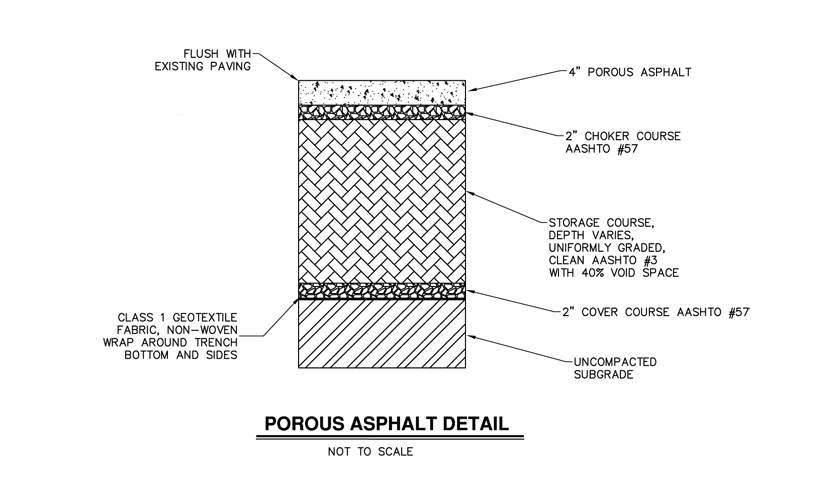
The space in between the coarser material provides a place for water to seep through to the soil underneath.
What are the advantages of porous pavement?
It can trap solids and pollutants that otherwise would’ve been carried to lakes and streams by stormwater collected in inlets. These pollutants seep through the pavement into a bed of rocks below, where they undergo the natural cleansing process that has purified our stormwater for hundreds of years before asphalt and concrete were invented.
It reduces stormwater runoff, thereby reducing the need for stormwater detention basins and stormwater infrastructure. Porous pavement allows the rain water to infiltrate the ground; therefore, it reduces the volume of stormwater runoff. This can reduce the number of inlets and storm pipes a client needs to be build (and reduce construction cost associated with that infrastructure).
See water infiltrate the porous pavement parking stalls almost immediately, while water collects on the conventional pavement outside the stall.
It can reduce flooding risks. Heavy rains can be absorbed into the ground instead of overloading inlets and detention basins.
It recharges the groundwater. Rain is absorbed back into the water supply, rather than being collected, stored and released from a detention basin.
It reduces the heat island effect of paved surfaces because air can circulate better through this material.
It reduces winter maintenance since the stone bed below the porous pavement tends to absorb and retain heat allowing snow to melt faster. So typically light snow and ice accumulation are handled with little to no maintenance.
What should you consider before investing in porous pavement?
It is coarser than traditional paving materials, but it is still fine enough to meet ADA standards and most people cannot tell the difference in appearance.
It must be carefully designed by engineers to work properly. The designer needs to know how quickly the soil beneath the pavement can absorb water (some soils absorb more quickly than others) and design the paving surface and stone bed accordingly. Otherwise, water can build up underneath the surface and can cause damage or surface flooding. Also, porous pavement is ideally suited for flatter surfaces to promote stormwater absorption and minimize the stone bed depth. On steeper surfaces benching or terracing of the stone bed is needed to maintain a reasonable stone bed depth and minimize excavation.
Maintenance requirements are different than they are for traditional pavement, depending on the material chosen. Certain materials require frequent vacuuming to prevent the voids or “pores” from being clogged. Sand or cinders should not be applied on or adjacent to porous pavement. More advanced materials – like elastomerically bound glass – have reduced maintenance needs.
Its strength rating is lower than traditional paving materials due to the increased air content. Therefore, it is not recommended for surfaces that will see heavy volumes of traffic or loading areas that will be frequented by large trucks. However, as the popularity of porous pavement continues to grow, many paving companies are developing higher strength materials.
What are the best uses for porous pavement?
Due to the lower strength of porous paving materials, it is best used for low-volume applications like:
- Parking spaces
- Residential alleys/roads
- Residential driveways
- Sidewalks and Walking paths
- Tennis Courts
Derry Township chose to pursue porous pavement in the West Caracas Avenue parking lot to meet the requirements of its MS4 stormwater management program and reduce the possibility of flooding. The porous pavement and vegetative islands in the lot are designed to completely infiltrate the runoff from a 100-year storm event and reduce the amount of sediment, nitrogen and phosphorous entering the watershed. This helps the township meet its Chesapeake Bay pollutant reduction plan goals.
Informational signage educates the public about the various Best Management Practices (BMPs) used in the lot and the benefits of infiltration to water quality. This helps the township meets the MCM #1 (public education) goal of its MS4 permit.
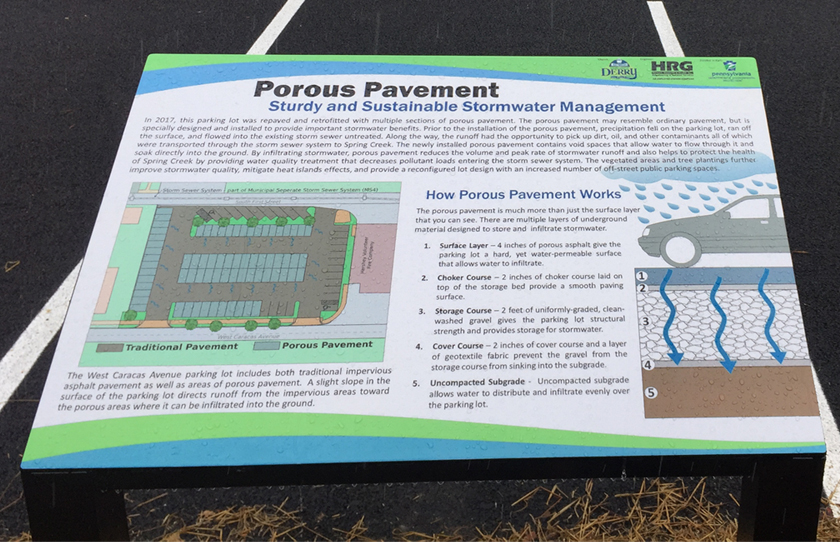
DEP awarded the township a $200,000 Local Stormwater BMP Implementation Grant, which covered almost half of the project cost.
But the new parking lot provides other benefits to the community besides improved water quality. It also accommodates more cars and has better access from local streets, too. This is important because it’s located in a busy section of downtown Hershey, where it serves visitors to the local restaurants, the Hershey Story museum, the Hershey Theater, and many local shops. It also accommodates Life on Chocolate events in ChocolateTown Square.
The West Caracas Avenue parking lot project shows that development and environmental benefits can peacefully coexist and be affordable for communities at the same time. Municipalities don’t have to choose between protecting water quality and promoting economic development; they just have to invest wisely.
Reduce the Cost of MS4 Compliance and Pollutant Reduction Plans Through Cooperation
/in Insights-Local Government, Insights-Municipal, Insights-Water Resources, Uncategorized /by Judy Lincoln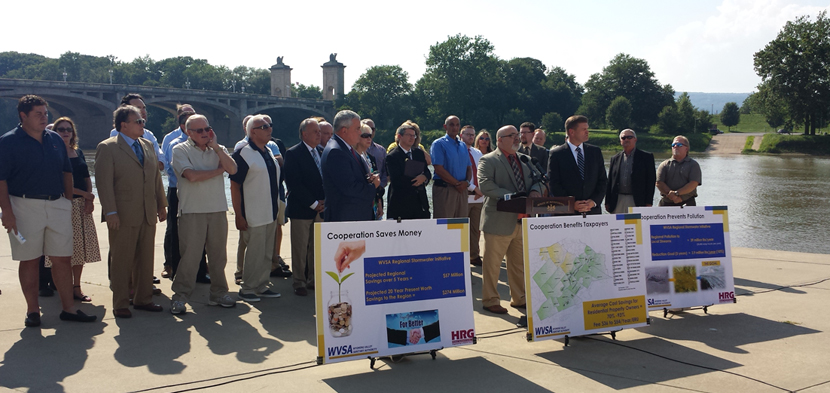
Stormwater management has become a major priority for environmental agencies over the past decade, and communities are struggling to meet the increasing requirements to reduce stormwater pollutants and runoff volume. The cost is simply too high for many municipalities to bear alone, but it becomes much more manageable if municipalities can share the burden with their neighbors.
Take the Pollutant Reduction Plan requirement of the MS4 application as an example. If a municipality submits a Pollutant Reduction Plan on its own, it is limited to constructing BMPs within its own borders or the drainage way of its impaired streams, but DEP will generally accept the construction of BMPs anywhere within the watershed for an MS4 permit that is submitted by a regional cooperative. This means cooperating municipalities can install BMPs that yield the greatest pollutant load reduction for the lowest cost.
Usually the largest expense associated with BMP construction is the cost of acquiring land on which to build the BMP. An individual municipality may not have much land on which to build, particularly if it is an urban municipality in which most of the available land has already been developed. As a result, the municipality may be forced to implement a large number of BMPs that each provide only marginal individual benefit in order to meet the pollutant reduction goal. If a municipality submits a regional plan with other communities in the same watershed, it will have access to a much greater land area on which to build BMPs and a reduced need for right-of-way acquisition and easements. This allows the participating municipalities to build the most effective water quality measures in the places with the greatest need.
Any improvements in upstream water quality will lead to improvements in downstream water quality, so a municipality can still see improvements in its water quality using a watershed-based approach even if a particular BMP is not located within that municipality’s borders.
When BMPs are constructed on a watershed-wide basis, the construction cost is typically lower due to economies of scale, and the water quality results are better.
Herbert, Rowland & Grubic, Inc. (HRG) is working with the Wyoming Valley Sanitary Authority on a regional stormwater collaboration that includes 32 municipalities in Luzerne County. These municipalities intend to meet 70% of their sediment reduction goal with a single BMP: conversion of existing flood control levees into a constructed wetland with a sediment forebay and a meandering stream channel.
Regional cooperation can save municipalities money in other ways besides BMP construction. For example, the cost of preparing the Pollutant Reduction Plan itself will be much lower as a result of cooperation due to economies of scale.
Hiring a consultant to assist with pollutant reduction planning can cost thousands of dollars. If that cost is shared with 10 other municipalities, each individual municipality only has to pay a small portion.
It’s like sharing your first apartment with two roommates when you were in your 20s. The fixed cost of rent and utilities is the same whether one person lives there or three, but each person pays less if they can split that cost three ways (instead of renting their own individual apartments).
Stormwater management involves many fixed costs like the cost of owning equipment to clean out inlets or conduct outfall inspections.
Spreading those costs across a greater number of users means each user pays a smaller price for service.
Another way cooperation can reduce the cost of stormwater management is by giving municipalities increased purchasing power. Generally, you can negotiate lower unit costs for items when you buy them in larger quantities. For example, cooperating municipalities could replace or slip line several miles of pipe for a lower cost if the work was completed as part of a larger, regional project. These savings apply to the bidding of services, too. The municipalities working with the Wyoming Valley Sanitary Authority saved hundreds of thousands of dollars on base mapping (i.e. orthophotography, impervious area, etc.) by participating with WVSA under a single project (rather than having each municipality bid its own contract).
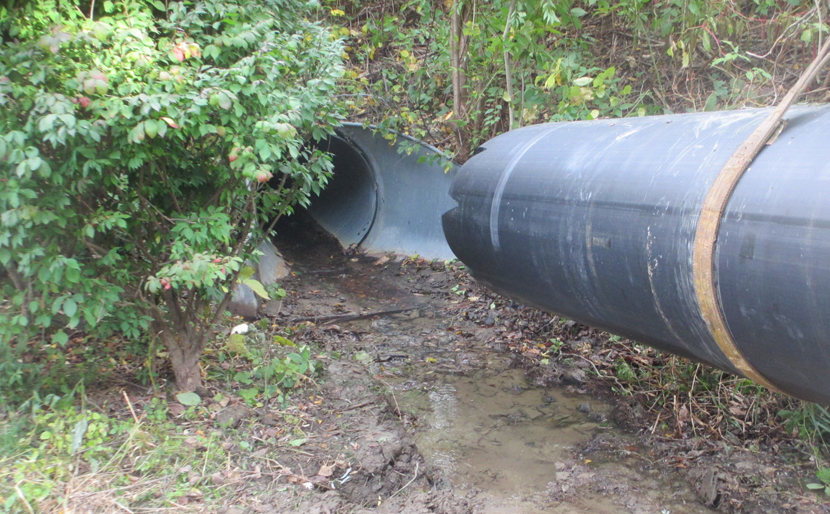
Municipalities have greater purchasing power when they cooperate on stormwater management solutions. For example, cooperating municipalities could slip line several miles of pipe for a lower cost if the work was completed as part of a larger, regional project.
A regional cooperative also has more borrowing power than a single municipality, and funding agencies are more likely to award a grant or loan to a regional project than one submitted by a single municipality. Funding agencies prefer regional projects because they believe regional cooperation streamlines costs, and politicians tend to support projects that benefit as large a constituent base as possible. A regional initiative should be tied together by legal agreements that assure the funding agency all funding will be properly administered. (These legal agreements are also required to meet DEP requirements for submission of a regional pollution reduction plan.)
This post is an excerpt from a longer article in the July-August-September issue of Keystone Water Quality Manager magazine. The article is focused on the cost savings communities enjoy by cooperating with regional partners on their stormwater management programs. Read the magazine for advice on finding partners for your stormwater management program or contact us to request a copy.

Erin G. Letavic, P.E., is the regional manager of civil engineering services in HRG’s Harrisburg office. She guides municipalities and cooperative groups throughout Pennsylvania through the management of their MS4 permits, provides grant application development and administration services, and provides retained engineering services to local government.

Adrienne Vicari, P.E. is the financial services practice area leader at Herbert, Rowland & Grubic, Inc. (HRG). She provides strategic financial planning and grant administration services to numerous municipal and municipal authority clients. She also serves as project manager for several projects involving the creation of stormwater authorities or the addition of stormwater to the charter of existing authorities throughout Pennsylvania.
How to Incorporate Green Infrastructure into Parks in order to Save Money Meeting Regulatory Requirements
/in Insights-Environmental, Insights-Landscape Architecture, Insights-Municipal, Insights-Recreation, Insights-Water Resources /by Judy LincolnThis article is the third in a series on incorporating green infrastructure into parks and recreational space in order to more cost-effectively meet environmental regulatory requirements. (Part 1 explained why parks are an ideal location for green infrastructure projects to meet regulatory requirements, and Part 2 explained the benefits of incorporating green infrastructure into parks.)
In this article, we provide advice on how communities can identify areas in their park and recreational spaces that are good candidates for green infrastructure and how to work with other groups to get these projects implemented. This article is an excerpt from an article we published in the April 2018 issue of Borough News magazine entitled “Parks Provide the Ideal Location for Meeting Environmental Regulatory Requirements.”
How can municipalities incorporate green infrastructure into their park facilities?
Start by taking an inventory of your facilities and look for places where green infrastructure could be used.
Pay close attention to your hard surface areas. These are the areas that generate the most runoff, so look for ways to reduce the amount of hard surface area or lessen its impact by directing runoff to pervious areas.
Look at your parking lots: How does stormwater flow across the lot? Are there landscaped areas or medians where you could incorporate bioretention facilities? Are there places where you could plant additional trees? Perhaps you could use permeable pavement in the parking stalls.
Watch this video to see a demonstration of how quickly permeable pavement in these municipal parking stalls absorbs a few buckets of water compared to the non-permeable pavement outside the parking stalls.
Do you have paved trails and walkways in your park system? Consider permeable pavement or a tree canopy that runs alongside the path. Because of their linear nature, bioswales can be planted alongside trails or paved paths, too. The following video shows how a system of bioswales along the bike trail in Indianapolis absorbs water during a rain event.
The Magnificent Bioswales & Stormwater Treatment Along the Indy Cultural Trail from STREETFILMS on Vimeo.
Could your athletic fields be used for a dry extended detention basin?
Do you have open space within existing drainage areas that could be used for constructed wetlands?
Do you have a community center? This would be a great location for a demonstration rain garden, rainwater harvesting system, or planter boxes. It could even be a candidate for a green roof.
Middletown Borough reduced the volume of stormwater entering their stormwater system by converting the traditional garden located between their municipal building and parking lot to a rain garden. By redirecting the building downspout to the rain garden, the stormwater that previously flowed across the parking lot is now infiltrated on site.
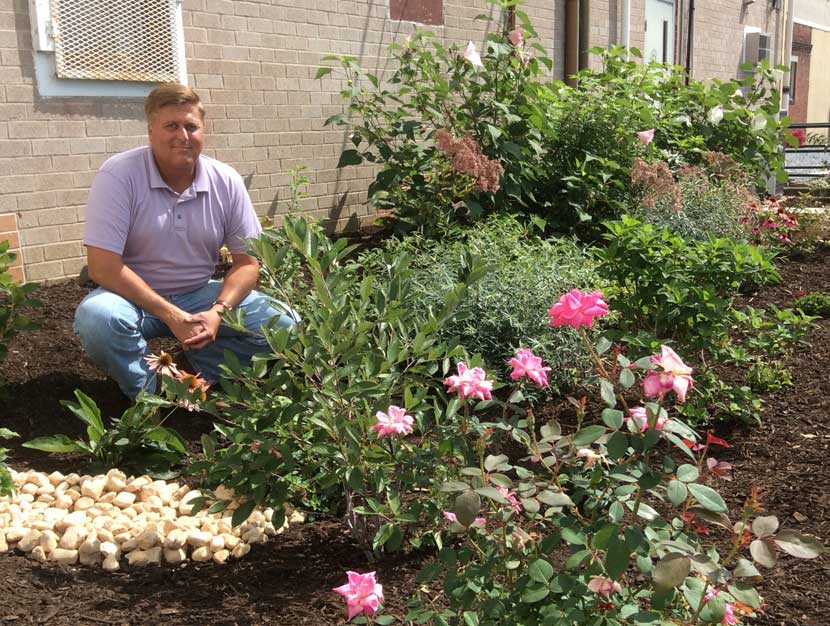
Check out this article in the Middletown Press and Journal about Middletown’s rain garden.
Successfully integrating green infrastructure into your park facilities is a team effort. Municipal administration, public works staff, planners, and the parks and recreation department should all work together to find cost-effective solutions that maximize benefits for the community.
But the teamwork shouldn’t end inside the government offices. Schools, conservation groups, gardening clubs, and other community groups may also want to lend a hand. Bringing them on board marshals additional resources for the cause and helps to build public support for the efforts.
Your municipal engineer can provide valuable guidance on design, regulatory requirements and even potential funding sources.
Municipal staff must be creative stewards of both the environment and the taxpayers’ money. Incorporating green infrastructure and streambank restoration projects into park and recreational facilities helps them do both. By using land the municipality already owns, communities can greatly reduce the cost of construction projects needed to comply with environmental regulation like the MS4 program. The native plantings used in rain gardens and bioswales typically need less maintenance and chemicals than turf grass, and rainwater collected in barrels can be used for irrigation or toilet flushing in order to lower water consumption costs.
At the same time, these projects prevent pollutants in stormwater runoff from reaching our lakes and streams, preserving them for recreational uses like fishing and swimming. They also help to prevent flooding, which ensures the parks department will be able to keep athletic fields and parks open for scheduled activities after a storm.
In these ways, green infrastructure can enhance the recreational experience for the user. It can also enhance the aesthetic appeal: Rain gardens and native vegetation can provide a habitat for wildlife and butterflies for safe public viewing and can serve as a quiet retreat for reflection.
Signage turns these features into an educational experience and helps to meet the educational outreach requirements of a community’s MS4 permit.
Working together as a team, municipal officials, planners, park professionals, and local community groups can protect our resources while providing exceptional recreational experiences for all.
 Ben Gilberti, P.E., manages civil engineering services provided by Herbert, Rowland & Grubic, Inc. (HRG) throughout Western Pennsylvania, Ohio and West Virginia. He assists with the design of municipal infrastructure like sidewalks, stormwater systems, and sewer facilities.
Ben Gilberti, P.E., manages civil engineering services provided by Herbert, Rowland & Grubic, Inc. (HRG) throughout Western Pennsylvania, Ohio and West Virginia. He assists with the design of municipal infrastructure like sidewalks, stormwater systems, and sewer facilities.
 James Feath, R.L.A., is a senior landscape architect at HRG. He has 20 years of experience in the planning and design of public spaces, including parks, trails, and recreational facilities.
James Feath, R.L.A., is a senior landscape architect at HRG. He has 20 years of experience in the planning and design of public spaces, including parks, trails, and recreational facilities.
Benefits of Installing Green Infrastructure in Parks for MS4 Compliance
/in Insights-Environmental, Insights-Landscape Architecture, Insights-Local Government, Insights-Municipal, Insights-Recreation, Insights-Water Resources /by Judy LincolnLast week, we shared how parks and recreational space can be the ideal location for green infrastructure and streambank stabilization projects that help you meet your MS4 compliance and pollutant reduction plan goals. This week we discuss the benefits of this approach in another excerpt from an article we published in the April 2018 issue of Borough News magazine.
As we stated last week, the latest round of MS4 permitting requires many municipalities to implement a pollutant reduction plan that reduces the level of pollutants in their stormwater by as much as 10%. This will likely involve the construction of Best Management Practices (BMPs) like rain gardens or streambank stabilization projects, and the most expensive part of BMP construction is often acquiring the land on which to build. This is why parks and recreational space can be an ideal location for BMPs because it’s land you already own; there are no land acquisition costs.
Middletown Borough is proposing to meet the majority of its MS4 pollutant reduction plan goal with the installation of a bioretention basin along the east side of Hoffer Park. This basin will be created by excavating an existing corrugated metal stormwater pipe and backfilling the trench with layers of bioretention bed components like engineered media, topsoil and mulch. Water-tolerant native plantings will then be planted there.
Wilkins Township in Allegheny County is also proposing improvements to one of its municipal parks as part of it MS4 pollutant reduction plan. The township is upgrading Lions Park to include ADA accessible routes, a paved walking trail, playground, deck hockey and pavilion. Many green infrastructure elements are being incorporated into the park design in order to manage stormwater on-site. For example, soil in all open spaces will be amended to enhance its structure and ability to promote infiltration. A rain garden will be planted along with vegetated channels and a vegetated filter strip, as well.
Green infrastructure can save money in other ways, too.
- Funding agencies often prefer projects that provide multiple benefits, so municipalities may be able to increase the opportunity for grant money by combining recreational and environmental goals into the same park improvement project. As part of the grant requirement for funding from the Pennsylvania Department of Conservation and Natural Resources, Lower Swatara Township integrated water quality BMPs into the rehabilitation plan for the playground at two of their community parks. The runoff from the playground area will be conveyed into rain gardens adjacent to the new playground and will be treated on site. The walkways from the parking area to the new playground will be porous asphalt to minimize the amount of runoff. Additionally, educational signage will be installed to educate playground visitors on the environmental and water quality benefits provided by the rain gardens.
- Captured rainwater can be used for irrigation or toilet flushing, thereby reducing potable water consumption.
By SuSanA Secretariat [CC BY 2.0 (http://creativecommons.org/licenses/by/2.0)], via Wikimedia Commons
A rainwater harvesting system
But the benefits of incorporating green infrastructure into your park facilities go beyond saving money:
Green infrastructure can improve the recreation experience for park users.
- Natural vegetation can provide a habitat for wildlife and offer the opportunity for wildlife viewing.
- Vegetation can also reduce noise and provide visual barriers to set off private areas for picnics or meditation.
- Green infrastructure helps to ensure adequate flows in ponds and streams , so that park users can enjoy them.
Photo by ChattocaneeNF. Used under a Creative Commons license.
- It is generally more attractive than large swaths of concrete piping and basins.
- It improves drainage, which means park facilities are less likely to flood (and less subject to closure or cancellation of activities after a storm). North Middletown Township has proposed a bioretention basin in Village Park as part of its Chesapeake Bay pollutant reduction plan, but an added benefit of the basin is that it will help to prevent the frequent flooding of a playground within the park during heavy rain events.
Green infrastructure can reduce maintenance.
- Standing water is a breeding ground for mosquitos, so maintenance personnel must be vigilant to prevent it. Improving drainage will reduce the effort needed to eliminate standing water.
- Turf grass can be high maintenance. Rain gardens and bioswales can be populated with native vegetation that requires less watering, no chemicals, and less mowing or weeding.
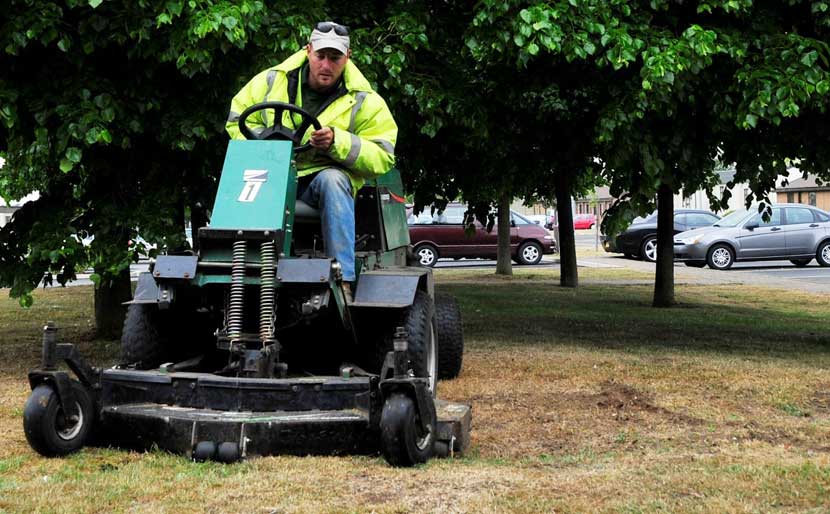
- Vegetation along streambanks can slow or even absorb runoff before it reaches the stream, thereby reducing erosion. The vegetative root structures hold sediment in place to further reduce streambank erosion.
Installing green infrastructure in parks provides an opportunity to educate the public and encourage good habits.
- Signs explaining how green infrastructure works can be used to meet MS4 education requirements under Minimum Control Measure #1. Cranberry Township, Butler County, is including signage about the bioswales they’re installing in Graham Park for this very reason. Schools and community groups can visit the site and learn how stormwater is managed. Park visitors can read the signs and may even be inspired to install green infrastructure on their own property. This extends the environmental benefits even further. The Wyoming Valley Sanitary Authority has pioneered an innovative regional partnership among more than 30 municipalities to cooperate on stormwater management and MS4 compliance. Their plan includes the creation of stormwater parks that will combine green infrastructure with signage to educate the public. (You can read more about WVSA’s award-winning initiative here. You can also read more about the wide-ranging services we’ve provided at Graham Park.)
Photo by Doug Kerr. Used via a Creative Commons license.

Signage turns green infrastructure in parks into an educational piece that can be used to meet MS4 MCM #1 requirements.
To sum it up: Incorporating green infrastructure into your park and recreational facilities allows you to provide a better experience for your residents while minimizing the cost of complying with environmental regulation and reducing future maintenance needs. It’s win-win-win!
In next week’s post, we’ll talk about how municipalities can incorporate green infrastructure into their parks and recreational spaces, including how to identify locations for green infrastructure and how to coordinate with other groups to get the projects built.
Ben Gilberti, P.E., manages civil engineering services provided by Herbert, Rowland & Grubic, Inc. (HRG) throughout Western Pennsylvania, Ohio and West Virginia. He assists with the design of municipal infrastructure like sidewalks, stormwater systems, and sewer facilities.
James Feath, R.L.A., is a senior landscape architect at HRG. He has 20 years of experience in the planning and design of public spaces, including parks, trails, and recreational facilities.
Cooperation Prevents Pollution in the Wyoming Valley
/in Insights-Environmental, Insights-Local Government, Insights-Municipal, Insights-Water Resources /by Judy Lincoln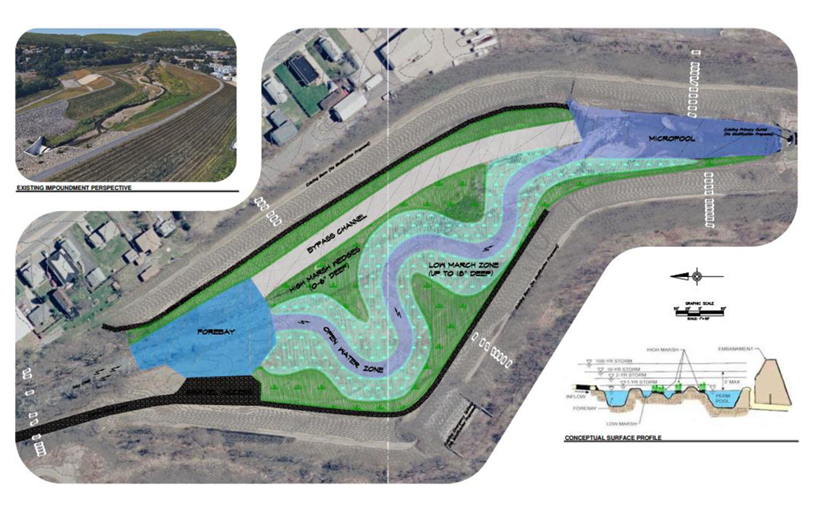
This article is an excerpt from the December issue of The Authority, a magazine produced by the Pennsylvania Municipal Authorities Association (PMAA). It is the third in a series of 3 articles about an innovative approach to stormwater management and MS4 compliance being pioneered by 31 municipalities and the Wyoming Valley Sanitary Authority.
Thirty-one municipalities in Luzerne County are piloting a regional approach to MS4 compliance that may revolutionize the way Pennsylvania responds to the growing challenges posed by stormwater.
They have signed cooperative agreements with the Wyoming Valley Sanitary Authority, which will serve as MS4 permit coordinator for the entire region. In our previous posts, we discussed the many ways a regional partnership can lower the cost of stormwater management for municipalities and the ways it is benefitting the taxpayers.
In this post, we’ll discuss how:
Cooperation prevents pollution.
Stormwater doesn’t recognize municipal boundaries. Pollution can travel through a watershed across multiple borders. Communities will be more effective at reducing pollution if they cut it off at the source, and that source may be in another municipality. This requires local governments to work together.
The same is true for flooding. Municipalities can better protect properties downstream if they address the source of the flooding upstream – even if that source is in a neighboring community.
A coordinated, regional approach will be much more effective at solving watershed problems than a fragmented approach where methods used by one municipality may be at odds with those used in another.
In the Wyoming Valley, the Pennsylvania Department of Environmental Protection has estimated local municipalities generate 39 million pounds of pollutants each year. These pollutants negatively impact local waterways, the Susquehanna River, and the Chesapeake Bay.
The regional approach being pioneered by the Wyoming Valley Sanitary Authority and its partners is projected to reduce this yearly pollutant load by 3.9 million pounds (or 10%).
The authority and its municipal partners will be implementing regional BMPS to accomplish this goal at a fraction of the cost they would’ve incurred if the municipalities were to go it alone.
The truth is: many municipalities are not able to meet the challenges stormwater brings on their own; the cost is too much for their budgets to bear. But they can reduce the cost – and make it manageable – if they share it with their neighbors through a regional approach to stormwater management like the one being pioneered in the Wyoming Valley.
By working together on a regional approach to MS4 compliance, municipalities there are estimated to save between 58% and 70% in capital costs over the next five years. They’ll save more than $200 million on operations, maintenance, and improvements over the next 20 years.
Cooperation saves money, benefits the taxpayer, and prevents pollution. Most importantly, it makes the seemingly impossible task of protecting our watersheds possible. We hear a lot these days about the challenges that face us, and there are many who are quick to say that the political climate or financial limitations prevent us from overcoming those challenges. But the example being set in the Wyoming Valley reminds us that no challenge is too big if people work together to conquer it.
Jim Tomaine has more than 30 years of engineering experience. He holds a bachelor’s degree in civil engineering from The Pennsylvania State University and a master’s degree in business administration from Wilkes University. He is the executive director of the Wyoming Valley Sanitary Authority and has been at WVSA for twenty seven years. Prior to the WVSA, Mr. Tomaine worked in the private sector as a design engineer. He currently holds his A-1 Wastewater Treatment Plant Operators Certification in Pennsylvania and is also a registered professional engineer.
Adrienne Vicari is the financial services practice area leader at Herbert, Rowland & Grubic, Inc. (HRG). In this role, she has helped the firm provide strategic financial planning and grant administration services to numerous municipal and municipal authority clients. She is also serving as project manager for several projects involving the creation of stormwater authorities or the addition of stormwater to the charter of existing authorities throughout Pennsylvania.
Regional Stormwater Plan to Save Taxpayers Money in Luzerne County
/in Insights-Environmental, Insights-Local Government, Insights-Municipal, Insights-Water Resources, Uncategorized /by Judy LincolnThis article is an excerpt from the December 2017 issue of The Authority, a magazine produced by the Pennsylvania Municipal Authorities Association (PMAA). It is the second in a series of 3 articles about an innovative approach to stormwater management and MS4 compliance being pioneered by 31 municipalities and the Wyoming Valley Sanitary Authority. You can read the first article here: How Municipalities in the Wyoming Valley Are Cutting Stormwater Costs by Up to 90% )

Thirty-one municipalities in Luzerne County are piloting a regional approach to MS4 compliance that may revolutionize the way Pennsylvania responds to the growing challenges posed by stormwater.
They have signed cooperative agreements with the Wyoming Valley Sanitary Authority, which will serve as MS4 permit coordinator for the entire region. In our previous post, we discussed the many ways a regional partnership can lower the cost of stormwater management for municipalities.
In this post, we’ll discuss how:
Cooperation benefits the taxpayer.
If regional cooperation lowers the cost of stormwater management, it stands to reason those cost savings will be passed on to the taxpayer. But, make no mistake, replacing aging infrastructure and constructing Best Management Practices will cost money, and that money will have to come from somewhere.
With municipal budgets already stretched to the limit, communities may have to consider new revenue sources. That could mean a tax increase or a stormwater fee.
Stormwater fees are generally a better deal for the average constituent. This is because a fee structure ensures everyone pays their fair share.
If taxes were raised to cover the cost of stormwater management, many property owners with large amounts of impervious area would be exempt: hospitals, schools, and other non-profit institutions. However, these institutions can sometimes be the biggest contributors to a community’s stormwater issues because stormwater runoff occurs when the water runs along impervious surfaces and cannot infiltrate the ground.
If stormwater management is paid for through a property tax increase, these non-profit organizations won’t pay for the services they’re using, but someone will have to, and that burden will fall on homeowners and small businesses.
Studies show time and again that the average homeowner would pay less for stormwater management if he or she were charged a stormwater fee than if the municipality raised property taxes.
The regional cooperation being pioneered by the Wyoming Valley Sanitary Authority is an especially good deal for local taxpayers: Our analysis showed that the average residential property owner will save 70 – 93% by paying a regional stormwater fee instead of paying an increased property tax.
The Wyoming Valley Sanitary Authority’s estimated stormwater fee is between $3.00 and $4.50 per month. This is lower than the other stormwater fees currently being paid throughout Pennsylvania, which average between $6.50 and $8.50 per month.
By using a regional approach, WVSA is able to lower costs beyond what an individual municipal authority could likely achieve. These numbers are even more impressive when you consider that the fees for most of the other municipal authorities included in the average above were calculated before taking 2018 MS4 permit requirements into account. Therefore, those communities may actually have to raise fees higher to meet the stricter requirements coming in the next permit cycle. WVSA’s estimated cost already accounts for the 2018 permit requirements.
Municipal leaders are stewards of the public’s money, but they are also stewards of the environment. In our next post, we’ll discuss how regional cooperation on stormwater management can more effectively keep our rivers and streams clean for drinking, agriculture, and recreation.
Jim Tomaine has more than 30 years of engineering experience. He holds a bachelor’s degree in civil engineering from The Pennsylvania State University and a master’s degree in business administration from Wilkes University. He is the executive director of the Wyoming Valley Sanitary Authority and has been at WVSA for twenty seven years. Prior to the WVSA, Mr. Tomaine worked in the private sector as a design engineer. He currently holds his A-1 Wastewater Treatment Plant Operators Certification in Pennsylvania and is also a registered professional engineer.
Adrienne Vicari is the financial services practice area leader at Herbert, Rowland & Grubic, Inc. (HRG). In this role, she has helped the firm provide strategic financial planning and grant administration services to numerous municipal and municipal authority clients. She is also serving as project manager for several projects involving the creation of stormwater authorities or the addition of stormwater to the charter of existing authorities throughout Pennsylvania.
How Municipalities in the Wyoming Valley are Cutting Stormwater Management Costs by up to 90%
/in Insights-Environmental, Insights-Financial, Insights-Local Government, Insights-Municipal, Insights-Water Resources /by Judy LincolnThis article is an excerpt from the December 2017 issue of The Authority, a magazine produced the Pennsylvania Municipal Authorities Association (PMAA). Contact us if you’d like a copy of the entire article.

Thirty-one municipalities in Luzerne County are piloting a regional approach to MS4 compliance that may revolutionize the way Pennsylvania responds to the growing challenges posed by stormwater.
They have signed cooperative agreements with the Wyoming Valley Sanitary Authority, which will serve as MS4 permit coordinator for the entire region. The following are just a few of the ways that partnership will save them money over the next 20 years:
Less paperwork.
Because the municipalities are submitting their permit requirements as part of a regional approach, the Department of Environmental Protection (DEP) is allowing them to submit just one Cheasapeake Bay Pollution Reduction Plan (PRP) for the region and a single PRP for each impaired watershed (for a total of seven Pollution Reduction Plans).
If each municipality had chosen to work alone, the region would’ve submitted more than 100 Pollution Reduction Plans to DEP. When the cost of producing one Pollution Reduction Plan can be more than $20,000, the cost to produce more than 100 would simply have been out of reach for this region.
But, by working together, the municipalities reduce the amount of paperwork that must be produced to comply with state requirements. Fewer plans cost less money, and that lower cost is then divided among the participating municipalities. At the end of the day, each municipality’s share of the Pollution Reduction Plan preparation cost is just $3,000.
Fewer, more efficient construction projects
Submitting the Pollution Reduction Plan is just step 1 of the compliance process. Once the plan is accepted by DEP, municipalities must implement it, and that typically involves the construction of Best Management Practices (BMPs) that reduce the quantity and/or improve the quality of stormwater runoff.
The most expensive part of constructing BMPs is acquiring the land on which to build them. When municipalities work alone, they are limited to constructing their BMPs within their own borders, and most municipalities don’t have an abundance of publicly owned land available for BMP construction. If they partner with other municipalities on a regional approach, they can get credit for constructing BMPs anywhere within the watershed. With that flexibility, communities can install projects that yield the greatest pollutant load reduction for the lowest cost. This often means they can meet their goals with fewer construction projects.
According to our analysis, municipalities in the Wyoming Valley would’ve had to construct approximately 200 projects to meet the pollution reduction goals individually (at a cost of $69 million). As a group, the municipalities will only need to construct 65 projects to meet those goals (at a cost of just $12 million). This will save the municipalities more than $50 million on the cost of implementing their Pollution Reduction Plans.
Lower O&M costs through economies of scale
There are a lot of fixed costs in managing stormwater. When you spread those costs over a larger number of users, the cost to each user gets smaller. A feasibility study conducted by WVSA’s engineer determined that, as a group, cooperating municipalities would save $274 million on operations, maintenance, and improvements over the next 20 years by working together on a regional approach to stormwater management.
Increased purchasing and borrowing power
Generally, you can negotiate lower unit costs for items when you buy them in larger quantities, so, for example, pipelines could be replaced or slip lined for a lower cost if the work was completed as part of a larger, regional project.
Increased access to government grants and loans
Funding agencies tend to favor entities that are cooperating regionally to streamline costs, and politicians tend to support projects benefitting a larger constituent base. Therefore, funding applications submitted by a regional cooperative are more likely to be awarded a grant or loan than those submitted by individual municipalities. These funding awards can save a community significant sums of money versus funding a project out of its own revenues.
When municipalities save money like this, it stands to reason they can pass those savings on to residents and business owners. In a follow-up post next week, we’ll discuss how the regional partnership model being pioneered in the Wyoming Valley is benefitting taxpayers in the region. In the final post of this series, we’ll discuss how regional cooperation prevents water pollution more effectively.
Jim Tomaine has more than 30 years of engineering experience. He holds a bachelor’s degree in civil engineering from The Pennsylvania State University and a master’s degree in business administration from Wilkes University. He is the executive director of the Wyoming Valley Sanitary Authority and has been at WVSA for twenty seven years. Prior to the WVSA, Mr. Tomaine worked in the private sector as a design engineer. He currently holds his A-1 Wastewater Treatment Plant Operators Certification in Pennsylvania and is also a registered professional engineer.
Adrienne Vicari is the financial services practice area leader at Herbert, Rowland & Grubic, Inc. (HRG). In this role, she has helped the firm provide strategic financial planning and grant administration services to numerous municipal and municipal authority clients. She is also serving as project manager for several projects involving the creation of stormwater authorities or the addition of stormwater to the charter of existing authorities throughout Pennsylvania.

 Learn more about our work with the Wyoming Valley Sanitary Authority in this 3-part series published in The Authority, a magazine published by the Pennsylvania Municipal Authorities Association.
Learn more about our work with the Wyoming Valley Sanitary Authority in this 3-part series published in The Authority, a magazine published by the Pennsylvania Municipal Authorities Association.